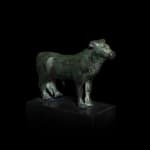Greek
A Greek bronze votive statuette of a bull, Boeotian, Classical Period, early 5th century BC
Bronze
Length: 13.3 cm
Naturalistically modelled, with short horns above his pointed ears, the poll incised, with round eyes, indented nostrils, incised zigzag for his teeth, ridges along the muzzle and the back of...
Naturalistically modelled, with short horns above his pointed ears, the poll incised, with round eyes, indented nostrils, incised zigzag for his teeth, ridges along the muzzle and the back of the neck, the long tail falling between the hind legs.
Provenance
Madame Marion Schuster (1902 - 1982) Collection, Lausanne, acquired before 1960, thence by descent to Mathilde Marion von Goldschmidt-Rothschild (1927 - 1993)Sotheby's, London, 10 July 1989, lot 80
With Royal-Athena Galleries, New York, 1990
John Kluge (1914 - 2010) Collection, Charlottesville, Virginia, acquired from the above
The Morven Collection of Ancient Art, Christie's, New York, 8 June 2004, lot 394
With Gordian Weber, Cologne, 2014
Private collection, Switzerland, acquired from the above
Exhibitions
Meisterwerke griechischer Kunst, Basel, Switzerland, 1960.The Divine and the Domestic: Ancient Art from the Mediterranean, Charlottesville, Virginia, Bayly Art Museum, 30 January - 22 March 1998.
Literature
Such bronze statuettes of bulls are most likely to have been votive dedications. For a very similar example in the Metropolitan Museum of Art, New York see acc. no. 20.37.4: G.M.A. Richter, Handbook of the Greek Collection, Harvard University Press, 1953, pp. 95, no. 235, pl. 75h.Animals, and particularly bulls, played an important part in ritual offerings in Classical Greece. Bronze figures of bulls were likely offered in place of actual animals and bull statuettes of varying size have been found at the major sanctuaries such as Olympia, Nemea, and Dodona. Similar bulls have also been discovered in Boeotia in the sanctuary of the Kabeiroi, and are now in the Athens National Museum (see B. Schmalz, Metallfiguren aus dem Kabirenheiligtum bei Theben, Berlin, 1980, p. 56, cat. no. 197, pp. 81ff., cat. no. 333, p. 90, cat. 361) and the Metropolitan Museum of Art, New York, acc. no. 20.210. The Kabirion of Thebes was one of the most important mystery cult centres of the little-known divine Kabeiroi.



